The Markets of Northwestern Spain: A Spanish Slow Food Tradition
Article and photos by Beebe Bahrami, Ph.D.
Resources updated 8/29/2023
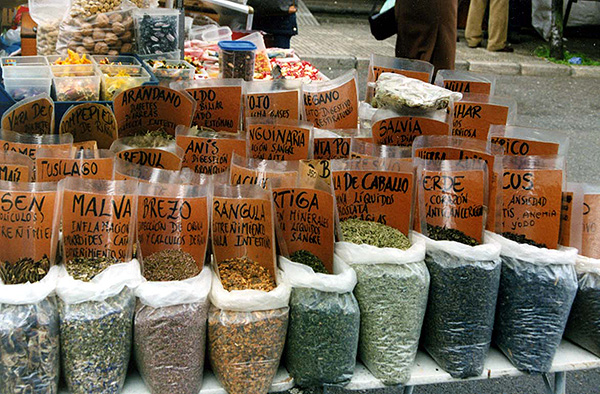
|
|
Medicinal herbs at the Ribadesella market. Photo © Beebe Bahrami.
|
Northwestern Spain is where enjoying food is similar to the Slow Food movement and has long been a way of life. People flock to the local markets every week to purchase fresh, locally-grown produce and other delicacies. This tradition has been passed down from generation to generation and is still strong today. It’s not just about the food. It’s about the community that comes together to celebrate this time-honored ritual. So, if you’re looking for an authentic culinary experience, look no further than northwestern Spain!
Since 1986, I have been going to Spain to live and visit as often as possible. From the post-Franco era, when the country embraced novelty, to its subsequent economic boom, Spaniards have always cherished the art of savoring life. They consider indulging in locally grown and produced food as a divine privilege. In fact, the average Spanish household spends more on food than any other budget item. This passion for gastronomy is evident in their frequent visits to tapas bars, daily excursions to bustling covered markets, and the lively atmosphere of weekly outdoor markets that grace towns and villages. The Spanish people’s zest for good food is one of the many reasons I find myself returning time and again. The other reason is their remarkable ability to revel in life’s simple pleasures — food and friendship. It’s no wonder Spain is known for its festive spirit, making it one of the most celebratory societies I’ve ever had the privilege of experiencing.
Explore the Culinary Traditions of the Northwest Atlantic Provinces
of Spain
Spain’s southern region was my first love, but I’ve been captivated by the north in recent years. The northwest provinces of Asturias and Galicia and the northern reaches of Castilla y León are a green, rugged, and narrow strip that brings imposing mountains close to the Atlantic coast. The region boasts several nearby microclimates and biological zones, offering an incredibly diverse local diet. The north is a food lover’s paradise, from the freshest seafood to succulent meats. So, if you’re looking for an authentic culinary experience that will tantalize your taste buds, head north!
Welcome to the green, Atlantic, and maritime northwest of Spain! This region is steeped in Celtic history and traditions passed down through generations. The locals still maintain their agricultural and fishing lifestyle. Still, with a growing tourist infrastructure, there’s never been a better time to visit. The food here is a feast for the senses, with locally grown and produced everyday fare. You can taste the love and care that goes into every bite of artisanal cheese purchased at the weekly market or small food shops sprinkled throughout Asturian and Galician towns. And don’t forget to try the local cider! A neighbor’s cider hut is the more likely place a villager buys his special golden elixir. Many visitors may not realize that the mouth-watering souvenirs they buy are what people eat and drink daily.
What I like to do in the northwest is rent a village house or apartment and then strike out every day on a footpath (Senda) or take the little train line, the FEVE, which snakes along the coast, to a new spot from which I will walk. Walking makes me happy and hungry, and I let my feet and sense of smell take me to one of myriad village or roadside lunch spots. I’ve learned that a village with 100 people will likely have two to three cafes and bars. Because eating well is an integral part of the Spanish day, they offer an authentic taste of the region. And when I’m not out exploring, I love to shop at the weekly markets and cook up a storm at “home” with the week's finds.
Step into the vibrant villages, towns, and cities of northwestern Spain, and you’ll be greeted by a feast for the senses. The weekly and covered markets are a food lover’s paradise, showcasing the region’s locally produced delicacies. From artisanal cheeses to venison or wild boar sausages, to several varieties of honey, to the many variations of apples that also go into making the local hard cider, sidra, to big leafy greens, little red peppers, famous beans known as fabas, and herbs that have been grown and harvested by hand by a seasoned herbalist and healer. Local vendors sell everything from garlic to clay pots to wooden spoons. And if you’re lucky, you might even come across a fisherman in Ribadesella selling his homemade fish pies. Similar to the Cornish or Welsh variety but 100 percent Asturian or Galician (empanadas), they’re his own recipe; he won’t divulge.
After over nine years of exploring the northwest, visiting the weekly and covered markets as a central vocation, here are a few I recommend to the first-time visitor:
Discover and Enjoy Oviedo
and its Markets
Asturias’ provincial capital has a magnificent covered market in the heart of the medieval neighborhood every morning. There, you can see all the varieties of locally produced foods and foods brought in from other parts of Spain, such as Andalucian olives, La Manchan saffron and cheeses, and Riojan wines. You will also be able to feast your eyes on the seasonal produce from just down the street: the honey, the locally cured sausages, and the myriad varieties of cheese made from northern goats, sheep, and cows you see grazing on green, lush grasses year-round on the hillsides and coastlines throughout the northwest. During Advent, locally gathered chestnuts are added to the cornucopia.
If you visit Oviedo on a Tuesday, you will also find the weekly market in full swing and wrapping around the outside of the covered market. It is a mix of locally grown and produced foods and herb sellers — both for culinary and curative purposes — craftspeople and clothing sellers. The market is a wonderful mix of agricultural peoples from around the world — local Asturians, South Americans, North Africans, West Africans, and Eastern Europeans. A man I met on a flight to Spain from Galicia told me, “The irony of our modern world is that we Galicians had to leave Spain and go to the New World for work or other parts of Europe. But now, so few of us are in Spain to tend the land and work the fishing boats that we have to hire people from where we emigrated to manage our lands and boats back home!” He sighed, ‘Each autumn, even when I am in New York, I feel all the chestnuts falling in the forest near my village in Galicia and lament that no one is there to gather them.”
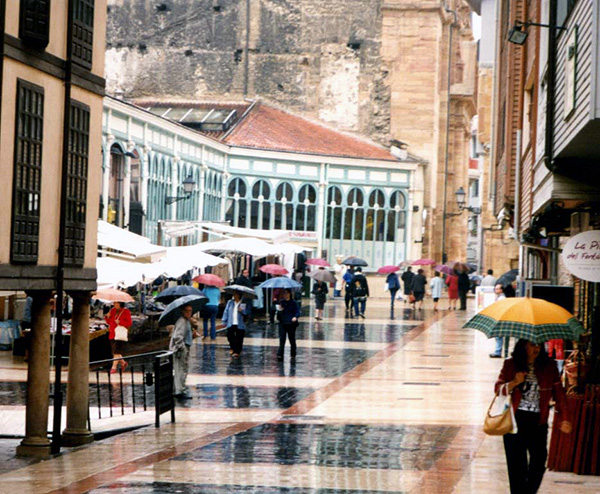
|
|
Oviedo's open-air and covered markets. Photo © Beebe Bahrami.
|
Santiago de Compostela
and its Markets
The pilgrim’s final destination in Galicia, Santiago de Compostela, has another colorful urban and exemplary covered market open daily in the morning. Just above this medieval town where pilgrims have been arriving for centuries, the covered market looks old, as if it has been feeding those pilgrims for hundreds of years in the same way. Near Rúa da Virxe da Cerca, the covered market is named after the plaza on which it stands, the Plaza de Abastos. The Mercado de Abastos is east of the cathedral and offers a mix of indoor and outdoor spaces, all guided by towering stone doorways and shelters. You will find seasonal fruits and vegetables, edible flowers, cheeses, fish, meats, honey, and local confections there. One of my favorite patronesses is a woman in her sixties who sets up her three or four baskets of just-picked little red peppers near one of the gray granite walls of the market. Her scale sits before her, and there is often a line. Galicia is famous for its grilled red peppers, soaked in garlic and olive oil and served as a tapa with hunks of crusty, local whole-grain bread.
Weekly markets offer an even more gratifying view and experience of the seasonal movement of foods. Because Galicia and Asturias are coastal and temperate climates, which get a lot of year-round rain, there is a 12-month growing season. You will find winter greens, similar to mustard greens or kale in winter. In summer, pit fruits dominate and continue into the fall. The best peach I ever ate was picked for me in October and was my dessert in a 3-course meal (costing €7!) in an unmarked village tavern near Cudillero. Everything in that meal was pulled from the kitchen garden next to the tavern when we ordered.
Picture this: My husband and I were strolling along one of the myriad footpaths that connect village to village in Asturias when we stumbled upon a hidden gem. We saw a black sign in the village center that said “Meson” with a big white arrow painted as we entered the small village. We followed the arrow, and then we heard voices and smelled food. Soon, we entered an unmarked stone doorway where stood a bar with every variety of elixir and a gathering of tables, one occupied by the cook and her friends as they played cards, waiting for the next visitor. We must have looked famished because the cook promptly got up, went to the garden, harvested a ripe tomato, plucked some crisp lettuce leaves, pulled up an onion, and continued to the kitchen to make us a green salad to accompany her pote de fabas. This hearty bean soup was also created with locally harvested vegetables, herbs, and meat from the pig down the road.
My Favorite Weekly Markets
in Northwestern Spain
My favorite weekly markets are in Sahagún (northwestern Castilla y León near Asturias), Padron (western Galicia), Luarca, and Ribadesella (both along the northern coast in Asturias).
In Sahagún, the town’s heart near the main square is overtaken by food sellers and craftspeople from all over León. They set up their tables and tents beneath the welcoming statue of a local son, Fray Bernadino de Sahagún, who is considered Spain’s first anthropologist because of his 16th-century study of the Aztecs. Inland and skirting the southern edge of Asturias, Sahagún is on the pilgrim’s road, the Camino, and once housed four communities in medieval times: Jews, Christians, Muslims, and pilgrims taking a break from walking or riding. These four communities were distinct and integrated, living together in symbiosis and mutual reliance. A small town today — and still receiving pilgrims on the Camino — you can still feel Sahagún’s history in its many medieval burnt ochre stone and brick buildings. All around the town are verdant vegetable gardens and well-tended sheep. If you wish to venture further afield, you’ll be greeted by sprawling vineyards that give birth to some of the region’s most exquisite wines.
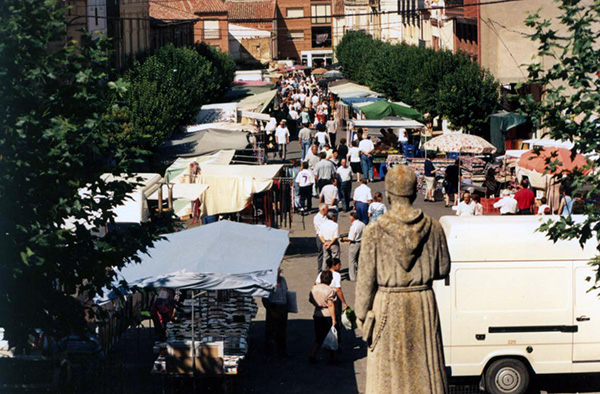
|
|
Sahugún's open-air market. Photo © Beebe Bahrami.
|
Padron’s weekly market is a vibrant affair that meanders throughout the town and onto the roads radiating out of town. At the heart of the market, you’ll find a bustling tent where merchants and visitors gather to enjoy a traditional breakfast of steamed octopus seasoned with paprika, accompanied by a hearty cup of red wine. The market is a treasure trove of culinary delights, offering everything from just-picked produce from the surrounding hills to fresh fish, churros, bread, locally cured cheeses, and sausages. As you explore the market, you’ll also come across unlabeled local vintages renowned for their exceptional quality. These wines are unlabeled because everyone knows the winemaker and their well-deserved reputation.
In Ribadesella, keep an eye out for that mysterious fisherman and his incredibly delicious onion, garlic, herb, and paprika-seasoned cod pies. The same food sellers who come to the coast also go to the mountain towns, only a few kilometers inland, to sell their harvest. Some hail from there, so you will likely find wild boar chorizo or venison chorizo as a part of the offering. The herb seller here lives in the mountains, grows organic herbs, and carefully harvests select wild ones from the hills.
Luarca’s weekly market takes over the whole town center, snaking up its terraced streets. One of my favorite stops there is the plant seller with her potted fragrant seedling herbs, baby tomatoes, and peppers ready for planting in a nearby garden. At the highest point in the most elevated street, we perch as husband and wife with our cheese and sausage. They love to give out samples, which inevitably result in a sale as the cheese and sausage squeal with peak flavor; I often purchase a Rioja or Castilla y León tinto, red wine, and a handful of olives to pair with these treasures for lunch.
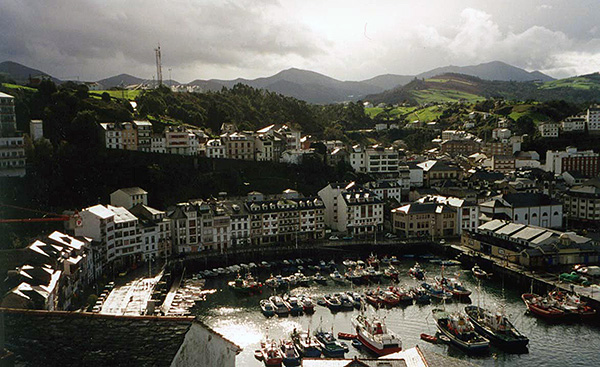
|
|
Luarca's fishing harbor. Photo © Beebe Bahrami.
|
Walking Paths
What to do in addition to exploring the rich culinary offerings?
If you love to walk or hike, follow the marked sendas, trails, as well as any other well-worm path as not all trials are well marked.
Be aware that you are trekking into some wild areas.
Tourist offices in Oviedo, and Santiago de Compostela can give you a guide to the inland and the coastal route of the Camino, the Pilgrim’s Road to Santiago de Compostela, which passes through Castilla y León, Asturias, and Galicia.
If you’re planning to trek into the wild areas of northwestern Spain, here are some tips to keep in mind:
-
Wear supportive trail shoes to protect your feet from the rugged terrain.
-
Be mindful of your surroundings and carry your trash out with you. You can deposit it in the receptacles in villages and towns, which do recycle.
-
Always have rain gear on hand. It’s not uncommon for it to rain in this region.
If you’re looking for adventure, there are plenty of activities to choose from:
-
If you’re a skiing enthusiast, then head to Picos de Europa during winter and spring. It offers some of Europe’s best skiing experiences.
-
If surfing is more your style, then check out the surf shops in Llanes, Ribadesella, and Tapia de Casariego. They can outfit you for a day of wave riding.
-
Kayaking is also popular, especially in the Ribadesella and Arriondas areas.
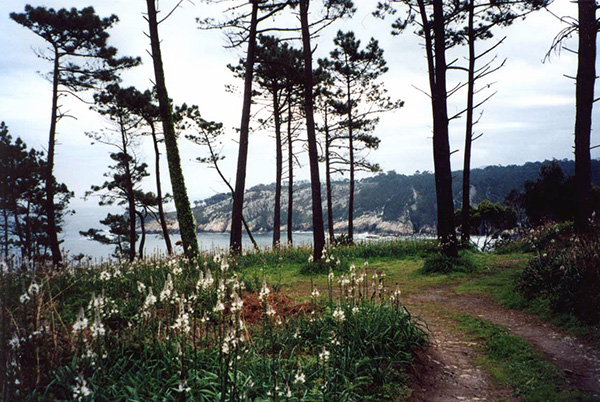
|
|
On a trail in Asturias. Photo © Beebe Bahrami.
|
|
Weekly Markets
Like the covered markets mentioned above, these start in the morning and go until lunchtime (2 p.m.).
Coastal markets:
Padron: Sunday morning,
Tapia de Casariego: Monday morning,
Llanes: Tuesday morning,
Luarca: Wednesday morning,
Ribadesella: Wednesday morning,
Navia: Thursday morning,
Cudillero: Friday morning.
Inland markets:
Cangas de Onis: Sunday morning,
Infiesto: Monday morning,
Salas: Tuesday morning,
Villaviciosa: Wednesday morning,
Arriondas (in the mountains, upriver from Ribadesella): Saturday morning,
Sahagún (in northern León): Saturday morning.
Sunday Rastros (Flea Markets):
Oviedo and Gijón. You can't miss these as they set up throughout the old towns and snake through the streets. Madrid also has its famous Rastro on Sunday, which is a fun thing to do if you are flying in or out of Madrid on a Sunday.
|
|
Getting Around
Getting to Spain (All airlines listed here also offer flights to Oviedo; Iberia and Spanair also fly to Santiago de Compostela.):
Plane: If you need more time, flight connections from Madrid will get you to Oviedo or Santiago de Compostela on Iberia or Spanair. There are twice-weekly flights on British Air from London to Oviedo as well. (The Asturian provincial airport is 40 minutes drive from Oviedo. Frequent buses connect to Oviedo city and other cities and towns.)
Train: If you have time, take the national train line, RENFE, which passes through exquisite plains, mountains, and valleys of the region.
Bus: Another viable option and equally beautiful, this takes less time, around 5 and 1/2 hours to the northwest by bus.
Local Transportation
On foot: In some northwest sendas, trails are marked with little signs and the trial's number. However, this needs to be more consistent. I have walked chiefly on unmarked trails and always found my way as they connect village to village. In other words, trails have a practical origin: to get people from point A to point B. For the adventurous, set out on a footpath while using all your sound senses, such as staying on the path, respecting the natural surroundings, and always asking. Spaniards, in general, are very social and people-oriented, and they are curious about visitors. Even with language as a barrier, they will find a way to understand you, and you decipher their words.
By bus: ALSA runs both national and local buses. Buses reach all the local destinations from Santiago de Compostela and Oviedo. Once you are in rural areas, local people know the bus schedules well. You can even ask the driver to drop you at an unmarked stopping place. The ALSA website shows the longer journey schedules. For local schedules, go to the bus stop in whichever town you live in and ask for roundtrip schedules for the specific destinations you want to make. The station attendant will give you a computer printout tailored to your travels. You can buy your ticket online for long journeys, but I always have experience buying it at the station.Suppose you are not traveling during one of the major holidays, like Holy Week (Semana Santa). In that case, you will have little trouble getting a seat on the bus. Even during Holy Week, when everyone seems to travel, ALSA increases its buses and departure times, but getting seats is fine.
By Rail: One of the delights of the northwest is the little, narrow gauge rail system run by the national train RENFE, which runs a corridor from Santander in Cantabria to Ferrol in Galicia. It is a pure delight to take this rail with its old-fashioned charm of train ticket attendants jovially greeting you and commuters doing the same as though you are a local going off to work or coming home. Its full schedule can be downloaded from the website. The train offers a serene way to witness the land's nuances.
By Taxi: Taxi stands in small and large towns and cities are marked by a squarish white sign with a big "T." Often, it is quicker and less expensive to take a taxi and arrange for a return a few hours later than to rent a car for those outings where rail or bus are harder to work out. Asturian and Galician coastal towns are small enough that everyone knows the cab drivers. Just wander into a bar and ask. Enjoy a great café con leche while you're there. (coffee never fails to be superb anywhere I've been in Spain over the past 20 years! I've only had one lousy cup in all that time.)
Car Rental: You can also rent a car in Oviedo or Santiago de Compostela. But renting a car eliminates the best way to meet local people and see how they live, so I never travel this way. But if time or easier mobility are issues, car rental can be procured from the airports.
|
|
Accommodations and Restaurants
All hotel pricing is based on double occupancy. Restaurant pricing is per person.
Oviedo: In Oviedo, I have always stayed in the Hotel Favila, near the train station in the heart of town. Over nine years, I have always been so happy at the family-run Favila that I have not looked elsewhere. It is straightforward, clean, and central to everything. There are many superb eating places in Oviedo. One that really brought out the local, seasonal fare was La Corte.
Luarca: El Baltico is run by a dear older man who takes his time to meet and greet each visitor. He runs a good place with an attached bar and restaurant. The rooms are simple, very clean, and overlook the harbor, where you can watch the fishing boats come and go all day and night. El Barometro, on the same harbor-front walk, is just a few doors down; going deeper into the harbor is a great place to sample fresh seafood and classic Asturian cooking. I have watched fishermen carry their just harvested catch into the restaurant where the husband and wife who own the restaurant turn the fish and shellfish into some of the most mouthwatering seafood fare available anywhere. El Barometro also offers an excellent fixed-price daily menu (menu del dia) that offers seasonal fare at more economical prices.
Llanes: I have stayed in two great places here. One is a village apartment in the village of Cue, about a mile and a half east of Llanes: Casa de Aldea El Juacu, Cue, Llanes. The other is in the neighborhood enclave of Pancar in the south of Llanes, connected by a delightful footpath into Llanes’ harbor area: Hotel el Canton, Pancar, 33509 Llanes. Eating is a good bet anywhere. Llanes has become a culinary destination in Asturias, drawing in foodies from all over Spain and Europe. Wander along the harbor and its off-shooting streets and go in where you fancy. It’s all good, and like El Barometro in Luarca, it’s all coming off the fishing boats in the harbor (or from the grass-fed cow up the road in the mountains).
Santiago de Compostela: To stay in the heart of town, I like the simple, inexpensive place near the cathedral, Hostal Suso. Be sure to taste the welcoming owner’s tapas in the bar downstairs. He often makes traditional and new inventions and serves them with drink orders. My favorite was his deep-fried saffron rice balls with Manchego cheese in the center. For more eating, as in Llanes, this is a foodie town. Wander throughout the medieval quarter around the cathedral, and you will find many excellent places to eat. You can find local culinary delights for any budget. Menu del dia are enticing, as are the a la carte seafood and mountain food offerings.
Outside the cities, I often forego hotels for rural apartments through Home Rental agencies, selecting Asturias or Galicia and then the locale within the province I want and for the desired duration.
|
Beebe Bahrami is a freelance writer and cultural anthropologist specializing
in travel, food and wine, and cross-cultural writing.
|
